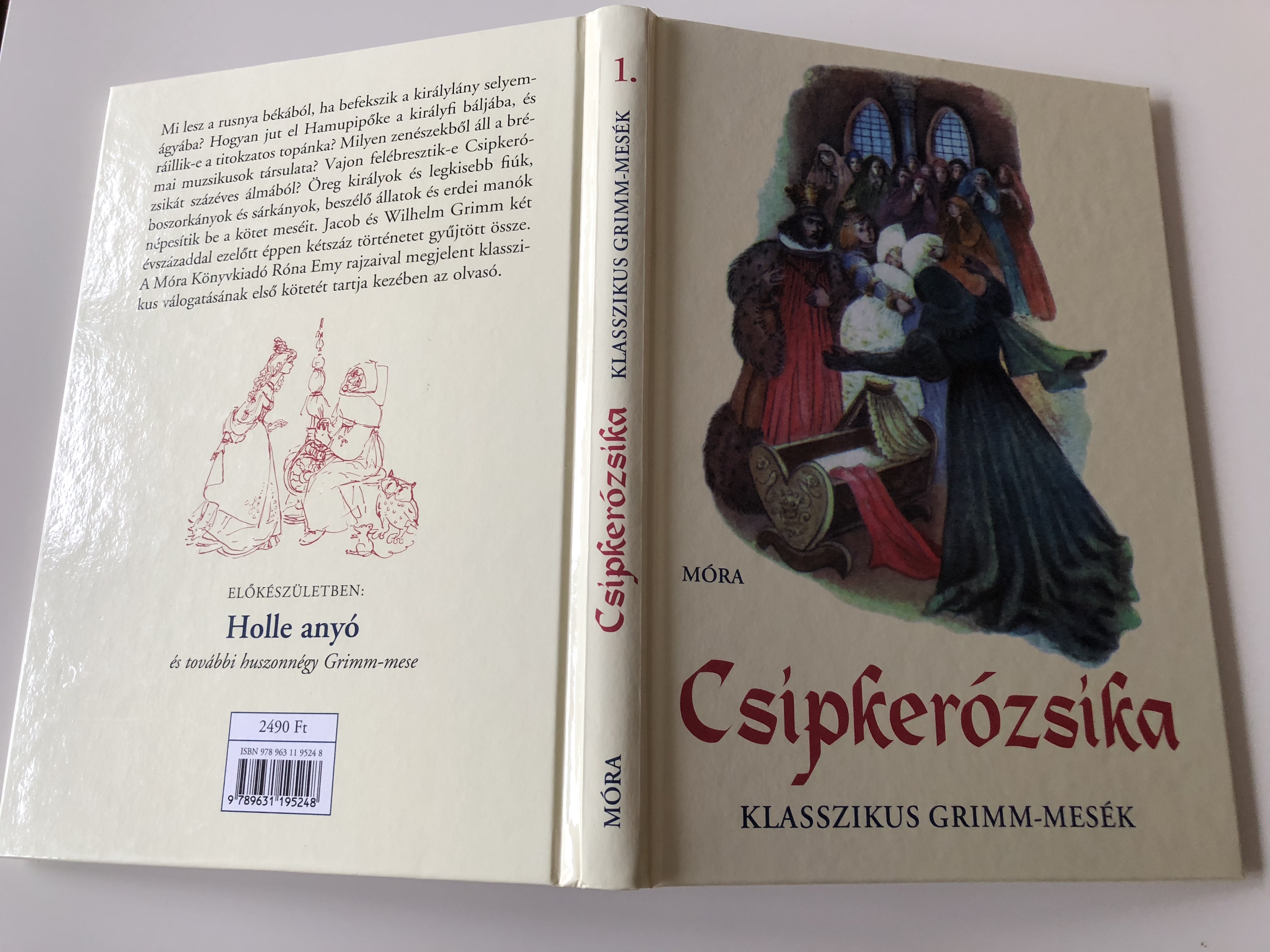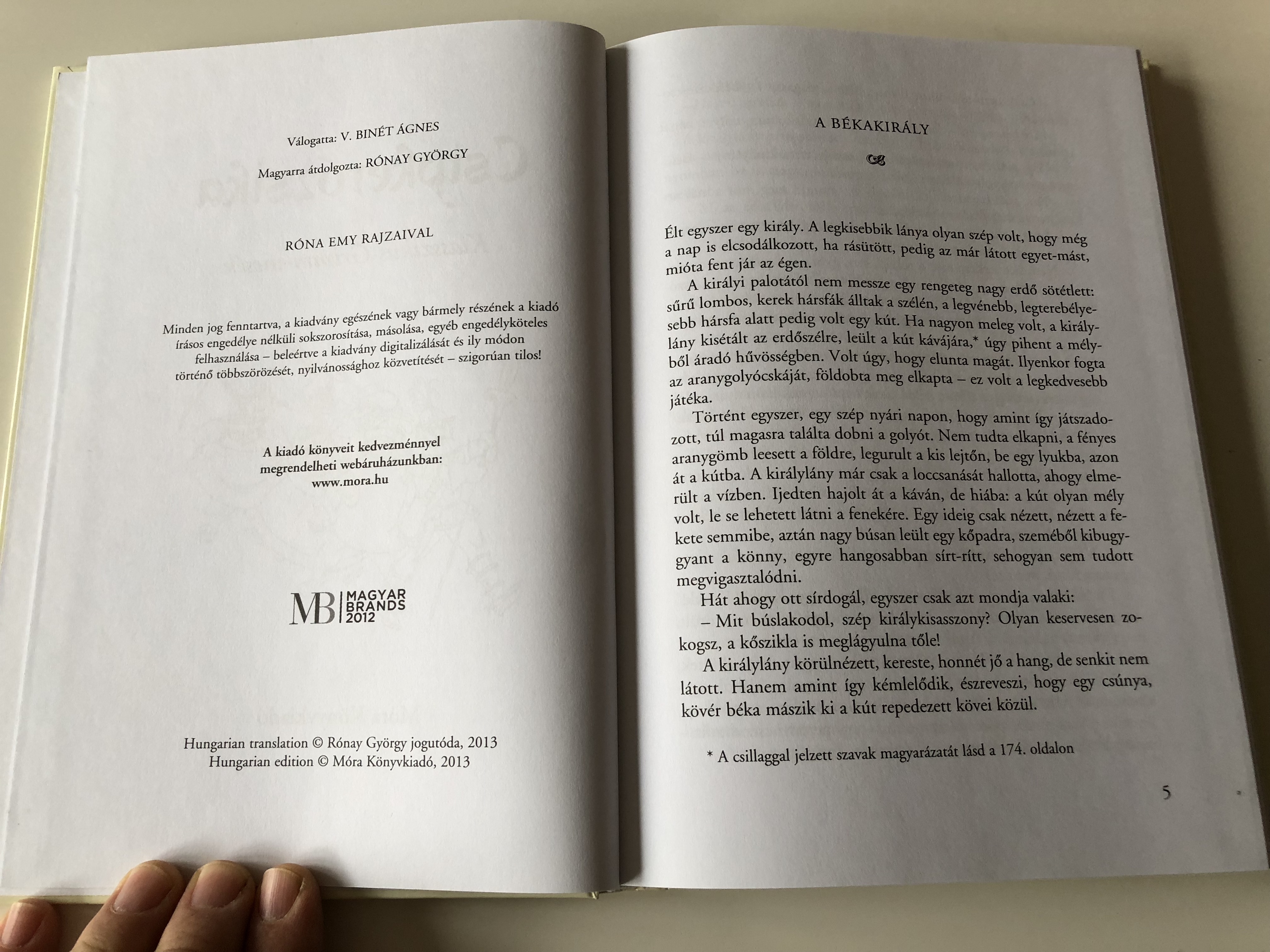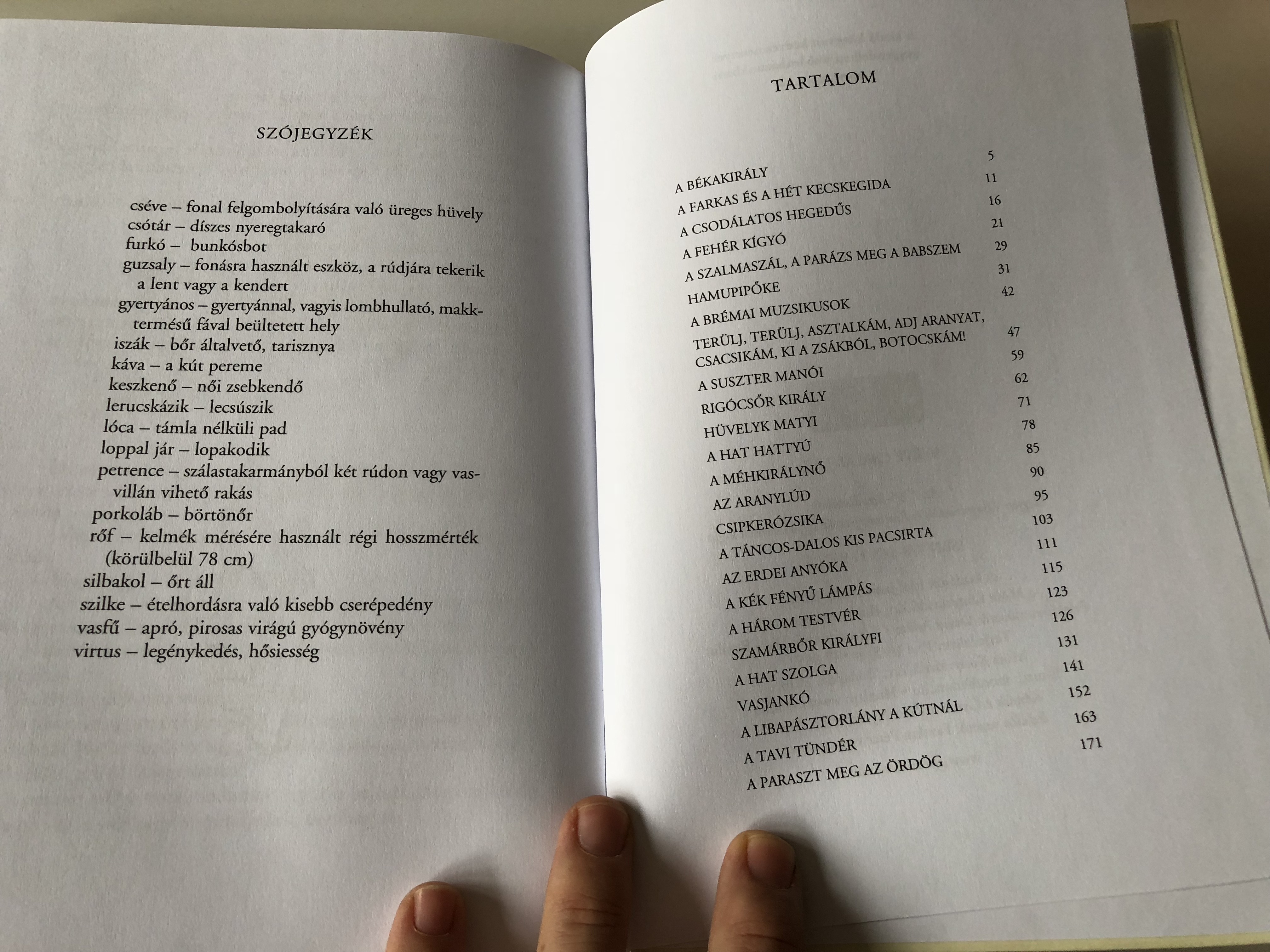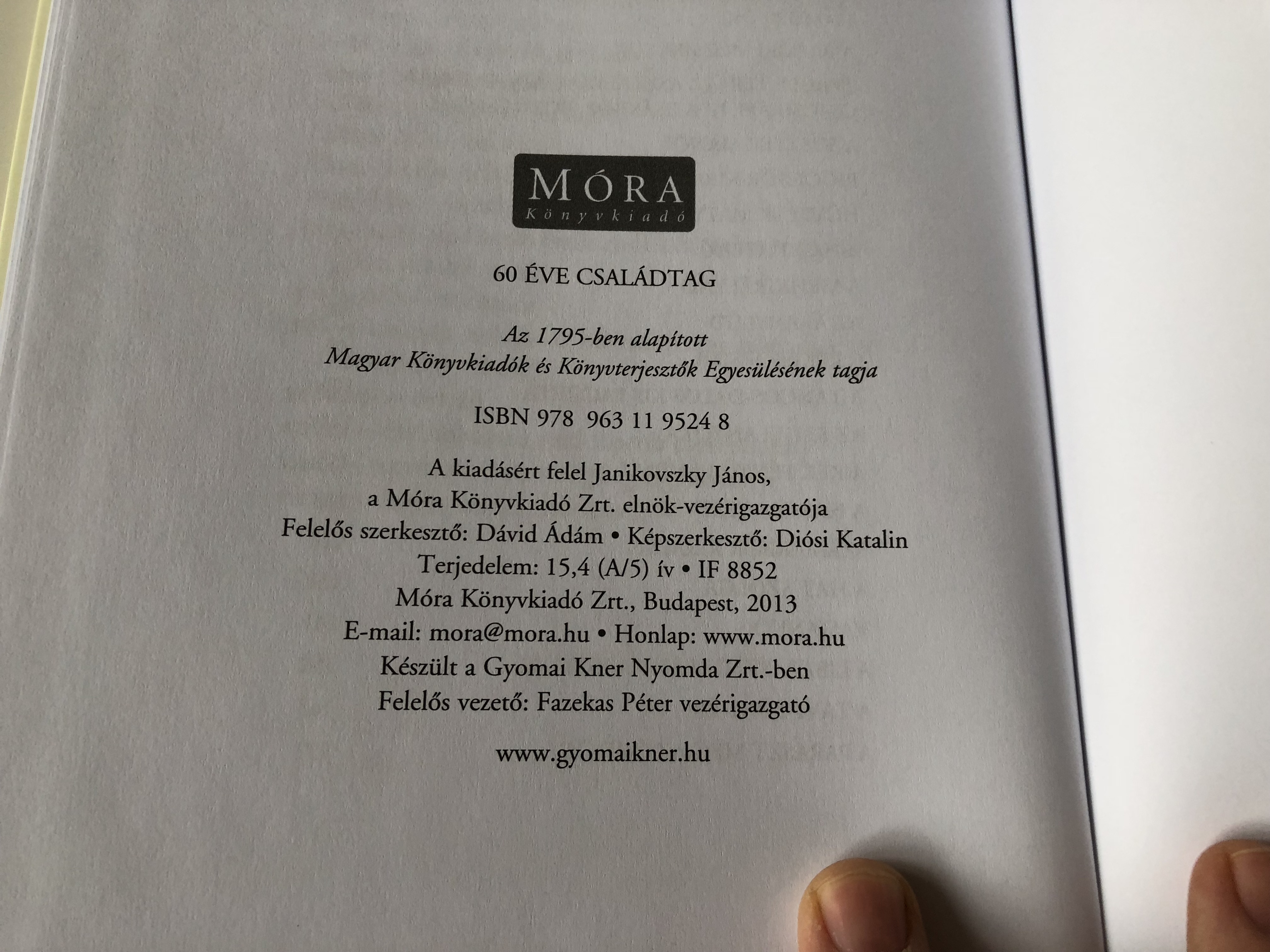Description
Csipkerózsika - Válogatta V. Binét Ágnes / Fordította Rónay György / Róna Emy rajzaival / Jakob Grimm · Wilhelm Grimm / Hardcover / Famous German Book Translated to Hungarian Language
Mi lesz a rusnya békából, ha befekszik a királylány selyemágyába? Hogyan jut el Hamupipőke a királyfi báljába, és ráillik-e a titokzatos topánka? Milyen zenészekből áll a brémai muzsikusok társulata? Vajon felébresztik-e Csipkerózsikát százéves álmából? Öreg királyok és legkisebb fiúk, boszorkányok és sárkányok, beszélő állatok és erdei manók népesítik be a kötet meséit. Jacob és Wilhelm Grimm két évszázaddal ezelőtt éppen kétszáz történetet gyűjtött össze. A Móra Könyvkiadó Róna Emy rajzaival megjelent klasszikus válogatásának első kötetét tartja kezében az olvasó.
A Csipkerózsika egy ismert tündérmese. Legismertebb változatát a Grimm fivérek adták ki 1812-ben a Gyermek- és családi mesék című gyűjteményükben. Az Aarne-Thompson - féle folklórbesorolásban 410 Csipkerózsika-típusú mesét találunk.
Először Charles Perrault francia meseíró írta le és jelentette meg Csipkerózsika addig szájhagyomány útján terjedő történetét (Lúdanyó meséi, 1697). Ebben, amikor megszületik Csipkerózsika, hét tündért hívnak meg nyolc helyett, viszont nem sokkal később megjelenik a nyolcadik tündér, aki elátkozza a hercegnőt, az átok szerint Csipkerózsika 16 éves korában meg fogja szúrni az ujját egy rokka orsója, és a szúrásba bele fog halni. A hetedik tündér, aki nem ajándékozta meg feloldja az átkot, miszerint nem hal meg csak elalszik 100 évre. A jóslat beteljesül. Ekkor a tündér mindenkit elaltat a kastélyban, kivéve a királyi házaspárt. A vár körül sűrű erdő növekszik. 100 év elteltével egy királyfi vetődik a várba éppen, amikor a hercegnő felébred. Feleségül veszi, de sokáig nem meri elvinni saját birodalmába, mert anyja emberevő fajtájú. Otthon mindig vadászatra hivatkozva rendszeresen elmegy. Születik két gyermekük: Hajnal és Nap. A királyfi apja meghal és ekkor nyilvánosan kihirdeti házasságát és elhozza családját a birodalmába. Hamarosan háború lesz és el kell mennie. Az anyja viszont sehogy sem tűrheti meg menyét és unokáit. Elküldi őket egy erdei házba. Ekkor utasítja a szakácsot, hogy főzze meg először az egyik majd a másik gyermeket, végül pedig a királynét. A szakács viszont mind háromszor bárányokat vág le. Mikor megtudja, hogy átverték nagy hordóban kígyót, békát és mindenféle férgeket hozat, hogy majd abba beleveti menyét és unokáit. Ám ekkor megérkezik fia. Végül beleveti magát és az állatok felfalják.
Sleeping Beauty (French: La Belle au bois dormant), or Little Briar Rose (German: Dornröschen), also titled in English as The Sleeping Beauty in the Woods, is a classic fairy tale which involves a beautiful princess, a sleeping enchantment, and a handsome prince. The tale was originally published by Charles Perrault. The version collected by the Brothers Grimm was an orally transmitted version of the original literary tale published by Perrault in Histoires ou contes du temps passé in 1697. This in turn was based on Sun, Moon, and Talia by Italian poet Giambattista Basile (published posthumously in 1634), which was in turn based on one or more folk tales. The earliest known version of the story is found in the narrative Perceforest, composed between 1330 and 1344.
A Hatot egy csapásra – A Grimm testvérek legszebb meséi, később a 2. évadtól A Grimm testvérek legszebb meséi (eredeti cím: Sechs auf einen Streich/Acht auf einen Streich) egész estés hosszúságú részekből álló, német televíziós filmsorozat, amelynek epizódjai a Grimm fivérek, Hans Christian Andersen és Ludwig Bechstein meséi nyomán készültek.
Sechs auf einen Streich beziehungsweise Acht auf einen Streich (Titel der 2. Staffel) ist eine deutsche Filmreihe des Ersten Deutschen Fernsehens mit Verfilmungen von Märchen bzw. Motiven aus Märchen, Erzählungen und Gedichten der Brüder Grimm, Hans Christian Andersens, Ludwig Bechsteins, Božena Němcovás, Christoph Martin Wielands, E. T. A. Hoffmanns und Hoffmann von Fallersleben, die das Erste Deutsche Fernsehen im Weihnachtsprogramm des jeweiligen Produktionsjahres erstmals ausstrahlt. In unregelmäßigen Abständen folgen Wiederholungen unter anderem in den regionalen Fernsehprogrammen. Regelmäßig gibt es Wiederholungen im "Märchenfilm im Ersten", jeden Sonntag um 11:00 Uhr auf "Das Erste". Von 2010 bis 2014 waren es unter Beibehaltung des Serientitels Sechs auf einen Streich nur noch vier Märchen pro Jahr, die verfilmt wurden. 2015 wurden erstmals wieder sechs Märchenfilme gedreht, wobei aber erneut nur vier Filme an Weihnachten ihre Premiere feierten. Die übrigen zwei Märchenfilme wurden zusammen mit zwei Märchenverfilmungen vom darauffolgenden Jahr Weihnachten 2016 gezeigt. Im Frühjahr 2017 wurden zwei neue Märchenverfilmungen für das Weihnachtsprogramm im selben Jahr angekündigt, wobei es auch blieb. Damit wurden erstmals nur zwei neue Märchen im selben Jahr verfilmt und zu Weihnachten dann auch gezeigt. Dafür erfolgte nach einer einjährigen Pause 2017 eine Neuauflage der Märchenperlen.
A Grimm fivérek, Jacob Grimm (Hanau, 1785. január 4. – Berlin, 1863. szeptember 20.) és Wilhelm Grimm (Hanau, 1786. február 24. – Berlin, 1859. december 16.) mesegyűjtőként és nyelvtudósként ismertek.
The Brothers Grimm (die Brüder Grimm or die Gebrüder Grimm), Jacob and Wilhelm, were German academics, philologists, cultural researchers, lexicographers and authors who together collected and published folklore during the 19th century. They were among the first and best-known collectors of folk tales, and popularized traditional oral tale types such as "Cinderella" ("Aschenputtel"), "The Frog Prince" ("Der Froschkönig"), "The Goose-Girl" ("Die Gänsemagd"), "Hansel and Gretel" ("Hänsel und Gretel"), "Rapunzel", "Rumpelstiltskin" ("Rumpelstilzchen"), "Sleeping Beauty" ("Dornröschen"), and "Snow White" ("Schneewittchen"). Their classic collection Children's and Household Tales (Kinder- und Hausmärchen), was published in two volumes, in 1812 and in 1815.
The brothers were born in the town of Hanau in Hesse-Cassel (now Germany) and spent most of their childhood in the nearby town of Steinau. Their father's death in 1796 impoverished the family and affected the brothers for many years after. They attended the University of Marburg where they began a lifelong dedication to researching the early history of German language and literature, including German folktales. The rise of Romanticism during the 18th century had revived interest in traditional folk stories, which to the Grimms and their colleagues represented a pure form of national literature and culture. The Brothers Grimm established a methodology for collecting and recording folk stories that became the basis for folklore studies. Between the first edition of 1812-15, and the seventh and final edition of 1857, they revised their collection many times, so that it grew from 156 stories to more than 200.[1] In addition to collecting and editing folk tales, the brothers compiled German legends. Individually, they published a large body of linguistic and literary scholarship. Together, in 1838 they began work on a massive historical German dictionary (Deutsches Wörterbuch), which, in their lifetimes, they completed only as far as the word Frucht, 'fruit'.
Many of Grimms' folk tales have enjoyed enduring popularity. The tales are available in more than 100 languages and have been adapted by filmmakers including Lotte Reiniger and Walt Disney, with films such as Snow White and the Seven Dwarfs and Sleeping Beauty. During the 1930s and 40s, the tales were used as propaganda by the Third Reich; later in the 20th century psychologists such as Bruno Bettelheim reaffirmed the value of the work, in spite of the cruelty and violence in original versions of some of the tales, which the Grimms eventually sanitized.












































